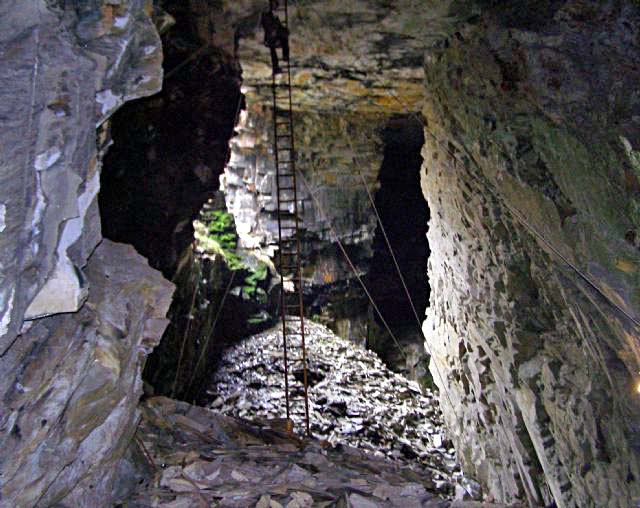|
Slate Mining The unique Ffestiniog narrow gauge railway was born because of slate. That ubiquitous building and roofing material discovered in the hills around Blaenau Ffestiniog. The production of slate products took a stupendous amount of labour by quarrymen. Soap Soap was a heavily taxed luxury item that only the rich could afford in Britain until Gladstone's budget of 1853 removed the soap tax. But tradition determined that if it was used, it was used sparingly, or replaced with lye. A quarryman's wife must have lived with an awful smell, washing her husband's shirt only once a month, or every two weeks if she was fussy. He went to bed in his shirt, vest, and flannel drawers which he'd worn all day sweating in the quarry. Quarrymen were afraid air or water might contact their skin, aside from their hands and face, of course. Laundering was labour intensive being accomplished with lye made from a mixture of wood ash, taken from grates or ovens, water, and perhaps urine. Sometimes domestic fowl droppings were added. Clothes were agitated in a barrel using a three-legged dolly peg. Should anyone be prosperous enough to own silk the item would be cleaned in liquid made from boiling grated potatoes in water. Tea Underground quarrymen worked in a dense, foggy, and frequently un-wholesome atmosphere. The quarry and slate sheds, being dusty, caused thirst which was eliminated by drinking tea. In the morning they drank one or two cups then took tea with them in cans to drink during meal break. When returning home in the evening they often had nothing but tea once again. Disease and Death The common diseases of the Blaenau Ffestiniog quarryman were diseases of the respiratory organs, rheumatism, and alimentary diseases such as indigestion. It was believed indigestion was due to the way they prepared their tea. It was their habit to send a boy, about a half hour before mealtime, to the caban (ka-Ban - A small eating house or shack in the mine usually made of slate) with tea, sugar, and water in the same kettle. This was then stewed for a half hour or more on a fire before the quarrymen drank it. This was thought to be the cause of the indigestion and other diseases that followed as a consequence. In 1893 the average age at death of those working in Blaenau Ffestiniog quarries and mines was 54 excluding accidents, only 52.6 if you
included accidents. During 1883-1892 there were 473 deaths in the slate industry. 73 were recorded as having died of Phthisis (also know as Consumption but properly known as Tuberculosis) and named in Welsh, Peswch y Llifiant (rasping cough). 43 of these were slate splitters and dressers, 19 rockmen and miners, 10 labourers, plus 1 other person. Men working the mills were coated with white dust. The slate dust particles are angular and give rise to irritation and coughing when inhaled. The term "silicosis" was first heard in Britain in 1870 but never known at Blaenau Ffestiniog even twenty years later. Llechwedd QuarrySlate quarries at Blaenau Ffestiniog were actually enormous underground chambers. At Llechwedd there are sixteen levels of them, one above the
other. Llechwedd Slate Mines was founded in 1846 by John Whitehead Greaves. Over time, 25 miles of underground railway serviced Llechwedd. Huge
chambers up to 50 or 85 feet in height were created. Quarrying was carried out entirely by candlelight. It could take two men up to twenty years
to excavate just one chamber. All useable slate blocks plus the rubble had to be winched to the surface for splitting into roof slates or disposal
on a tip. It was dangerous work down there in the dark. J.W. Greaves was a pioneer in the development of the slate sawing table. Power was initially supplied by huge water wheels and later by
steam-driven engines. Inclines provided a connection between various levels at the Llechwedd quarry. Horses were used for haulage until
battery-electric locomotives were introduced in the 1920s. The dangerous practice of man-riding on the inclines surely resulted in injury. One
particular contraption, called in Welsh, car gwyllt (wild car), was used by quarrymen at the end of the day to
careen down steep inclines on the way home. Virtually little more than a wooden plank on wheels one can easily imagine serious injury or death
occurring. Vancouver Island |

